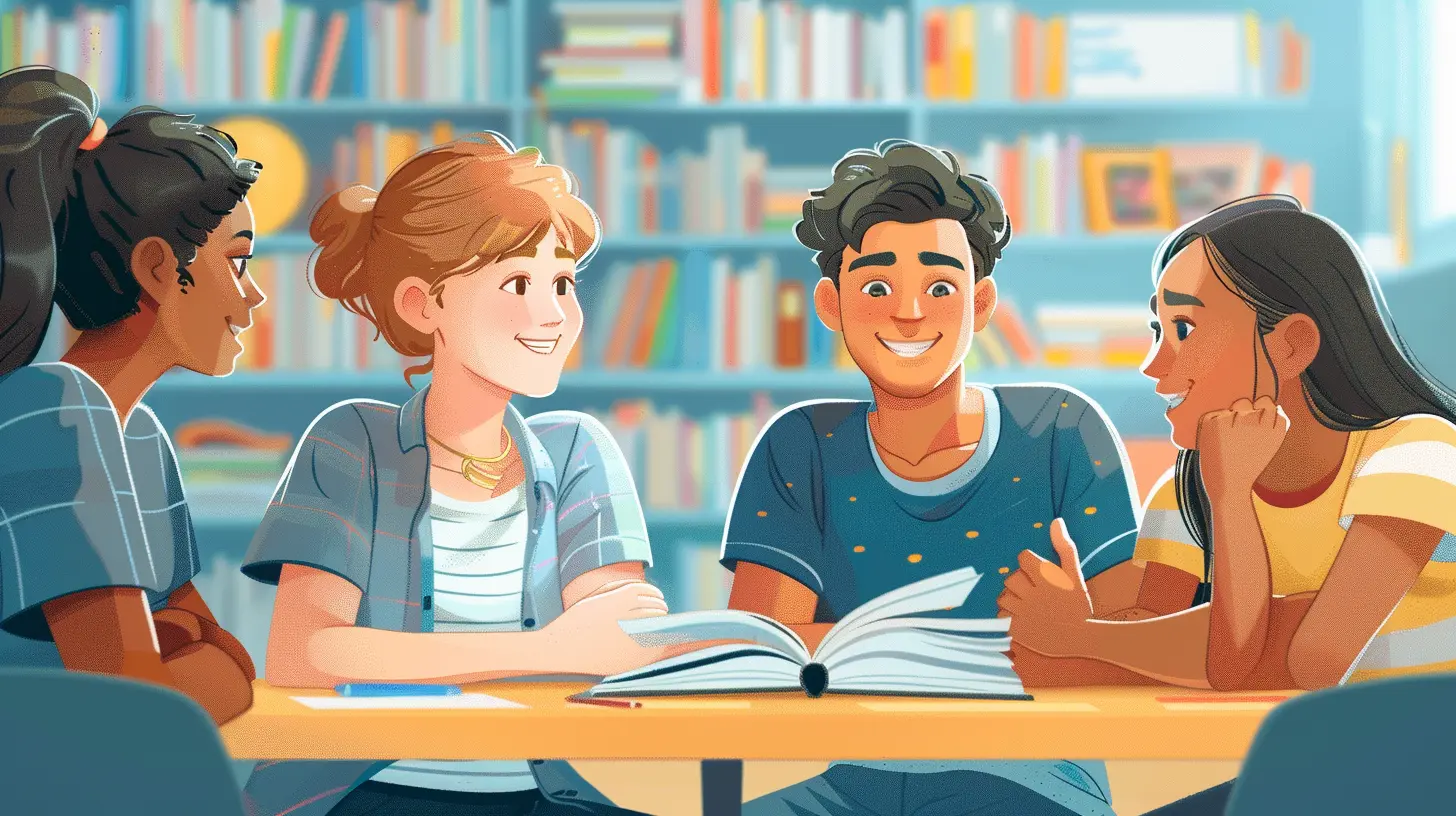Peer Tutoring Techniques for Effective Learning
16 December 2024
Peer tutoring has become an increasingly popular method of learning in educational settings. It's not just about students helping each other out with homework or studying for exams; it’s a well-structured approach that positively impacts both the tutor and the tutee. But how can we make peer tutoring even more effective? What are the best peer tutoring techniques that can lead to successful learning outcomes?
In this article, we’ll dive deep into peer tutoring techniques that actually work and help create an engaging and productive learning environment for students. Whether you're a teacher planning to implement peer tutoring or a student looking to help your peers, these strategies are sure to come in handy.
What Is Peer Tutoring?
Peer tutoring is essentially a teaching method where students help each other learn. One student takes on the role of the tutor, guiding another student (the tutee) through a specific subject or topic. Unlike traditional teacher-led methods, peer tutoring is more informal and often feels less intimidating, fostering a collaborative learning environment.Remember those times in school when you found it easier to understand a concept after a friend explained it to you? That’s peer tutoring in action! It’s not just about exchanging information, it’s about building a mutual understanding.
But why does it work so well? The relationship between the tutor and the tutee is more relaxed, making it easier for the tutee to ask questions, seek clarification, and even make mistakes without the pressure of formal assessments. Plus, the tutor gets to reinforce their knowledge by teaching others—a win-win for both parties!
Benefits of Peer Tutoring
Before we get into the nitty-gritty of techniques, let’s look at some of the benefits that make peer tutoring such a powerful educational tool:1. Active Learning
Peer tutoring encourages active involvement from both the tutor and the tutee. The tutee isn’t passively listening to a lecture; they’re engaging in conversation, asking questions, and actively trying to understand the material.2. Improved Communication Skills
For the tutor, explaining a concept in simple terms helps improve their communication skills. They must break down complex ideas into digestible bits, benefiting not only the tutee but also their own understanding.3. Increased Confidence
Tutees often feel more comfortable asking questions in a peer setting than in front of a teacher or a large class. This boost in confidence can drastically improve their learning experience.4. Collaborative Learning
Peer tutoring fosters a collaborative learning environment where students work together to solve problems and learn new concepts. This can have a positive impact on social skills, building teamwork and cooperation.
Peer Tutoring Techniques for Effective Learning
So, how do you make peer tutoring as effective as possible? Here are some proven techniques to ensure that both the tutor and tutee get the most out of the experience.1. Set Clear Objectives
Just like any other learning activity, peer tutoring sessions need clear objectives. Without a goal, it’s easy to get off track. Whether it’s mastering a specific math concept or improving reading comprehension, both the tutor and tutee should know what they’re aiming to achieve by the end of the session.Pro Tip: Write down the objectives before starting each session. This creates a roadmap for the tutoring session and keeps both parties focused.
2. Create a Comfortable Environment
For peer tutoring to be effective, you need to create an environment where both the tutor and tutee feel comfortable. This means building trust, encouraging open communication, and ensuring that the tutee doesn’t feel judged or pressured. The more at ease the tutee feels, the more likely they are to ask questions and engage deeply with the material.Analogy: Think of it like gardening. To help a plant grow, you need to provide the right conditions—sunlight, water, and good soil. In peer tutoring, the "soil" is the environment. The better it is, the more the student will "grow."
3. Use Active Learning Techniques
Learning isn’t a spectator sport! Both the tutor and the tutee should actively engage with the material. One of the best ways to do this is through active learning techniques such as:- Questioning: Encourage the tutee to ask questions, and the tutor should also ask clarifying questions to gauge understanding.
- Summarizing: After learning a concept, ask the tutee to summarize what they’ve learned. This not only reinforces the concept but also highlights any areas of confusion.
- Problem-Solving: Instead of just discussing concepts, work through problems together. This is especially effective in subjects like math or science.
4. Peer Modeling
Sometimes, the best way to learn is by observing. Peer modeling is when the tutor demonstrates a skill or concept, and the tutee observes before trying it themselves. This technique is especially useful in subjects that require step-by-step processes, such as math equations or writing essays.Example: Let’s say the tutee is struggling with solving algebraic equations. The tutor can first solve a few equations while explaining each step, then have the tutee attempt similar problems afterward.
5. Break Down Complex Concepts
One of the best skills a peer tutor can develop is the ability to break down complex concepts into smaller, more manageable pieces. This makes it easier for the tutee to grasp challenging material without feeling overwhelmed.Tip: Use analogies or real-world examples that the tutee can relate to. For instance, if you’re explaining fractions, you might refer to slicing a pizza into different portions. This makes abstract concepts more tangible.
6. Provide Positive Reinforcement
Everyone loves a good pat on the back! Positive reinforcement is a fantastic motivator in peer tutoring. Whenever the tutee makes progress or answers a question correctly, offer praise and encouragement. This builds confidence and promotes a positive learning experience.Pro Tip: Even when the tutee makes mistakes, use constructive feedback. Instead of saying, "That’s wrong," try, "You’re on the right track, but let’s take another look at this part."
7. Rotate Roles
Who says the tutor always has to be the same person? In many cases, rotating roles can be incredibly beneficial. This technique, often referred to as “reciprocal peer tutoring,” allows both students to take turns being the tutor and the tutee.Why is this useful? By teaching their peer, students can reinforce their own understanding of the subject matter. Plus, it keeps the learning dynamic and engaging.
Metaphor: Think of peer tutoring like a dance. Sometimes you lead, and sometimes you follow. Both roles are important!
8. Use Visual Aids and Learning Tools
Visual aids can be a game-changer in peer tutoring sessions, especially for students who are visual learners. Diagrams, charts, flashcards, and even digital tools like educational apps can enhance understanding and retention.Example: If the tutor is explaining a complicated biology concept like photosynthesis, using a diagram to show how the process works can make all the difference.
9. Incorporate Reflection
At the end of each peer tutoring session, take a few minutes to reflect. Both the tutor and tutee should review what was covered and identify areas where more work is needed.Tip: Ask the tutee questions like, “What do you feel more confident about now?” or “What’s still confusing you?” This helps both parties understand what went well and what needs improvement.
10. Be Patient and Flexible
Lastly, patience is key. Learning takes time, and not every session will go as smoothly as planned. Tutors should be flexible, adapting their teaching methods to meet the needs of the tutee. If one explanation doesn’t work, try another! Remember, the goal is learning, not perfection.
Implementing Peer Tutoring in the Classroom
Now that we’ve covered the best techniques, you might be wondering how to implement peer tutoring in a classroom setting. Here are a few tips:- Pair Students Thoughtfully: Consider academic ability, personality, and learning styles when pairing students. The goal is to create complementary pairings where each student can benefit from the other.
- Set Guidelines: It’s important to set clear expectations and guidelines for peer tutoring. Make sure both the tutor and tutee understand their responsibilities.
- Monitor Progress: Teachers should periodically check in on peer tutoring sessions to ensure they’re productive and that both students are benefiting.
Wrapping It Up
Peer tutoring is a powerful educational tool that benefits both the tutor and the tutee. By using techniques such as setting clear objectives, providing positive reinforcement, and incorporating active learning, you can ensure that peer tutoring sessions are both effective and enjoyable.So next time you're in a study group or working with a classmate, consider applying some of these strategies. Who knows? You might just find that teaching others is one of the best ways to learn yourself!
all images in this post were generated using AI tools
Category:
Peer TutoringAuthor:

Zoe McKay
Discussion
rate this article
19 comments
Zephyrae Clarke
This article on peer tutoring techniques is a valuable resource for educators and students alike. It highlights practical strategies that foster collaboration and deeper understanding. By implementing these techniques, learners can benefit from diverse perspectives and reinforce their knowledge, making education more engaging and effective for everyone involved.
February 2, 2025 at 12:53 PM

Zoe McKay
Thank you for your kind words! I'm glad you found the article helpful for fostering collaboration and enhancing learning experiences.
Benjamin Clayton
Thank you for sharing these valuable peer tutoring techniques! I appreciate the practical tips and insights. It's inspiring to see how collaborative learning can enhance understanding and foster a supportive educational environment. Looking forward to implementing these strategies in my practice!
January 27, 2025 at 5:27 AM

Zoe McKay
Thank you for your kind words! I'm glad you found the techniques valuable and inspiring. Best of luck implementing them in your practice!
Ryder Sanchez
This article offers valuable insights into peer tutoring techniques that can significantly enhance the learning experience. I appreciate the emphasis on collaboration and communication, as these skills are essential for both tutors and learners. Implementing these strategies could foster a supportive and engaging educational environment. Thank you for sharing this informative piece!
January 24, 2025 at 4:19 AM

Zoe McKay
Thank you for your kind words! I'm glad you found the insights on collaboration and communication valuable for enhancing the learning experience. Your feedback is much appreciated!
Candace Wood
Great article! Peer tutoring can be such a powerful tool for both students and tutors. It's wonderful to see strategies that foster collaboration and build confidence in learners.
January 21, 2025 at 8:29 PM

Zoe McKay
Thank you for your kind words! I'm glad you found the article valuable and appreciate the importance of peer tutoring in enhancing learning experiences.
Callista McDowney
Peer tutoring fosters collaborative learning, enhancing comprehension through teaching and discussion. Techniques such as structured sessions, goal setting, and reflective feedback can significantly boost student engagement and accountability, ultimately leading to improved academic performance and confidence in learners.
January 18, 2025 at 9:40 PM

Zoe McKay
Thank you for highlighting the key benefits of peer tutoring! Your emphasis on structured sessions and reflective feedback truly underscores its potential to enhance student engagement and academic success.
Haven Wilkerson
This article on peer tutoring techniques offers valuable insights into enhancing student learning. By fostering collaboration and communication, peer tutoring not only reinforces academic skills but also builds confidence. Implementing these strategies can create a supportive learning environment that benefits both tutors and tutees. A must-read for educators!
January 16, 2025 at 9:02 PM

Zoe McKay
Thank you for your thoughtful comment! I'm glad you found the insights on peer tutoring valuable. Empowering students through collaboration truly enriches the learning experience for everyone involved.
Nina Newman
Great insights! I'm intrigued by how peer tutoring fosters collaboration and enhances learning. Excited to explore these techniques and see their impact on education!
January 14, 2025 at 8:30 PM

Zoe McKay
Thank you! I'm glad you found the insights valuable. Exploring peer tutoring can truly transform the learning experience. Enjoy your journey!
Michelle McGinn
Peer tutoring fosters collaborative learning, enhancing comprehension through diverse perspectives. By sharing knowledge, students not only reinforce their understanding but also build essential communication skills. Implementing structured peer tutoring techniques can significantly improve academic outcomes and empower students to take ownership of their learning.
January 8, 2025 at 1:31 PM

Zoe McKay
Thank you for your insightful comments! I completely agree that peer tutoring not only improves comprehension but also empowers students to communicate effectively and take charge of their learning. Your perspective highlights the multifaceted benefits of collaborative learning.
Dixie Walker
Unlock hidden knowledge: explore how peer tutoring can transform learning experiences, revealing secrets of collaboration and understanding yet to be discovered.
January 1, 2025 at 8:53 PM

Zoe McKay
Thank you for your insightful comment! Peer tutoring indeed opens new avenues for collaboration and deepens understanding, enhancing the learning experience for everyone involved.
Jonah Summers
This article effectively highlights peer tutoring as a powerful learning strategy. By fostering collaboration and communication, it enhances understanding and retention. The emphasis on diverse techniques encourages adaptability, catering to various learning styles, ultimately creating a more inclusive and engaging educational environment.
December 29, 2024 at 4:02 AM

Zoe McKay
Thank you for your insightful comment! I'm glad you found the emphasis on collaboration and diverse techniques valuable for creating an inclusive learning environment.
Derek Young
Great insights on peer tutoring! The emphasis on collaborative learning really highlights its impact on student engagement and understanding. Looking forward to implementing these techniques in my own practice!
December 26, 2024 at 9:26 PM

Zoe McKay
Thank you for your feedback! I'm glad to hear you're excited to implement these techniques. Collaborative learning can truly transform student engagement!
Zia Huffman
This article offers valuable insights into peer tutoring techniques that enhance learning. The practical strategies outlined can significantly improve student engagement and comprehension. Implementing these methods in the classroom could foster collaboration and reinforce knowledge, making it a worthwhile read for educators.
December 22, 2024 at 12:30 PM

Zoe McKay
Thank you for your thoughtful feedback! I'm glad you found the strategies beneficial for enhancing student engagement and collaboration.
Kieran Meyers
Peer tutoring: where knowledge meets friendship and learning dances like a caffeinated squirrel! 🐿️✨ Whether swapping math woes or history hacks, these techniques transform study sessions into enlightening adventures. Remember, a little quiz here, a fun role-play there, and voila—education becomes a party! Let’s turn those brain cells into dance partners!
December 18, 2024 at 9:12 PM

Zoe McKay
Absolutely! Peer tutoring not only enhances academic skills but also fosters connections and makes learning enjoyable. Let's keep the energy high and the knowledge flowing! 🎉📚
Jennifer McDowell
Peer tutoring fosters collaboration and enhances understanding. Utilizing diverse techniques, such as role reversal and active questioning, can maximize engagement and effectiveness.
December 18, 2024 at 1:54 PM

Zoe McKay
Thank you for your insightful comment! I completely agree that collaboration and diverse techniques are essential for maximizing the effectiveness of peer tutoring.
Elara McAndrews
Great insights! Peer tutoring fosters collaboration and enhances understanding—it's a powerful tool for effective learning. Keep inspiring!
December 18, 2024 at 5:55 AM

Zoe McKay
Thank you! I appreciate your feedback and couldn't agree more about the power of peer tutoring in enhancing learning.
Delia McHugh
Peer tutoring transforms education by empowering students to take charge of their learning—no apologies needed!
December 17, 2024 at 9:29 PM

Zoe McKay
Thank you for your insightful comment! I completely agree that peer tutoring fosters student empowerment and actively engages learners in their educational journey.
Hesper McInerney
Great article! Peer tutoring can really transform learning experiences. Engaging students in teaching one another fosters collaboration and reinforces understanding. I love the practical techniques you shared—they're not only effective but also fun! Looking forward to implementing these strategies in the classroom!
December 17, 2024 at 1:14 PM

Zoe McKay
Thank you for your kind words! I'm glad you found the techniques valuable and fun. Best of luck implementing them in your classroom!
Blair McNair
Peer tutoring fosters collaborative learning through techniques like structured feedback, reciprocal teaching, and active engagement, enhancing understanding and retention while boosting confidence and social skills among students.
December 16, 2024 at 11:59 AM

Zoe McKay
Thank you for your insightful comment! I completely agree that structured feedback and active engagement are key components of peer tutoring, enriching the learning experience and building essential skills in students.
Kassandra Rogers
Peer tutoring fosters collaboration and understanding, allowing students to learn from each other’s strengths. Emphasizing active engagement transforms the learning experience into a shared journey.
December 16, 2024 at 3:55 AM

Zoe McKay
Thank you for your insightful comment! I completely agree that peer tutoring not only enhances collaboration but also enriches the learning experience through active engagement.
MORE POSTS

Formative Assessment for Social-Emotional Learning: A Holistic Approach

The Importance of Networking While Studying Overseas

Formative Assessment Techniques for Elementary Educators

Building Student Engagement: Tips for New Teachers

Health Literacy: Teaching Students to Make Informed Decisions

The Role of Humor in Effective Communication

The Role of Artificial Intelligence in Supporting Teacher Workload

How to Avoid Distractions in Online Learning

Navigating Cross-Generational Communication in the Workplace

Mentorship: A Critical Component of Leadership Development in Education

The Importance of Self-Discipline in Distance Learning

The Influence of Ancient Greece on Modern Culture